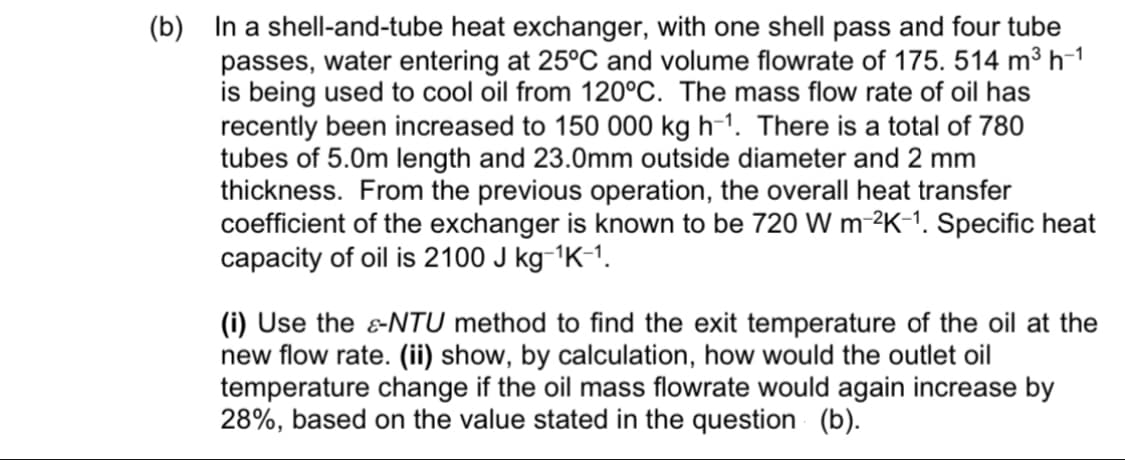(b) In a shell-and-tube heat exchanger, with one shell pass and four tube passes, water entering at 25°C and volume flowrate is being used to cool oil from 120°C. The mass flow rate of oil has recently been increased to 150 000 kg h-1. There is a total of 780 tubes of 5.0m length and 23.0mm outside diameter and 2 mm thickness. From the previous operation, the overall heat transfer coefficient of the exchanger is known to be 720 W m2K-1. Specific heat capacity of oil is 2100 J kg-1K-1. 175. 514 m3 h-1 (i) Use the &NTU method to find the exit temperature of the oil at the new flow rate. (ii) show, by calculation, how would the outlet oil temperature change if the oil mass flowrate would again increase by 28%, based on the value stated in the question (b).
(b) In a shell-and-tube heat exchanger, with one shell pass and four tube passes, water entering at 25°C and volume flowrate is being used to cool oil from 120°C. The mass flow rate of oil has recently been increased to 150 000 kg h-1. There is a total of 780 tubes of 5.0m length and 23.0mm outside diameter and 2 mm thickness. From the previous operation, the overall heat transfer coefficient of the exchanger is known to be 720 W m2K-1. Specific heat capacity of oil is 2100 J kg-1K-1. 175. 514 m3 h-1 (i) Use the &NTU method to find the exit temperature of the oil at the new flow rate. (ii) show, by calculation, how would the outlet oil temperature change if the oil mass flowrate would again increase by 28%, based on the value stated in the question (b).
Principles of Heat Transfer (Activate Learning with these NEW titles from Engineering!)
8th Edition
ISBN:9781305387102
Author:Kreith, Frank; Manglik, Raj M.
Publisher:Kreith, Frank; Manglik, Raj M.
Chapter10: Heat Exchangers
Section: Chapter Questions
Problem 10.12P
Related questions
Concept explainers
Heat Exchangers
Heat exchangers are the types of equipment that are primarily employed to transfer the thermal energy from one fluid to another, provided that one of the fluids should be at a higher thermal energy content than the other fluid.
Heat Exchanger
The heat exchanger is a combination of two words ''Heat'' and ''Exchanger''. It is a mechanical device that is used to exchange heat energy between two fluids.
Question

Transcribed Image Text:(b) In a shell-and-tube heat exchanger, with one shell pass and four tube
passes, water entering at 25°C and volume flowrate
is being used to cool oil from 120°C. The mass flow rate of oil has
recently been increased to 150 000 kg h-1. There is a total of 780
tubes of 5.0m length and 23.0mm outside diameter and 2 mm
thickness. From the previous operation, the overall heat transfer
coefficient of the exchanger is known to be 720 W m-2K-1. Specific heat
capacity of oil is 2100 J kg-1K-1.
175. 514 m3 h-1
(i) Use the &NTU method to find the exit temperature of the oil at the
new flow rate. (ii) show, by calculation, how would the outlet oil
temperature change if the oil mass flowrate would again increase by
28%, based on the value stated in the question (b).
Expert Solution
This question has been solved!
Explore an expertly crafted, step-by-step solution for a thorough understanding of key concepts.
This is a popular solution!
Trending now
This is a popular solution!
Step by step
Solved in 4 steps with 4 images

Knowledge Booster
Learn more about
Need a deep-dive on the concept behind this application? Look no further. Learn more about this topic, mechanical-engineering and related others by exploring similar questions and additional content below.Recommended textbooks for you

Principles of Heat Transfer (Activate Learning wi…
Mechanical Engineering
ISBN:
9781305387102
Author:
Kreith, Frank; Manglik, Raj M.
Publisher:
Cengage Learning

Principles of Heat Transfer (Activate Learning wi…
Mechanical Engineering
ISBN:
9781305387102
Author:
Kreith, Frank; Manglik, Raj M.
Publisher:
Cengage Learning